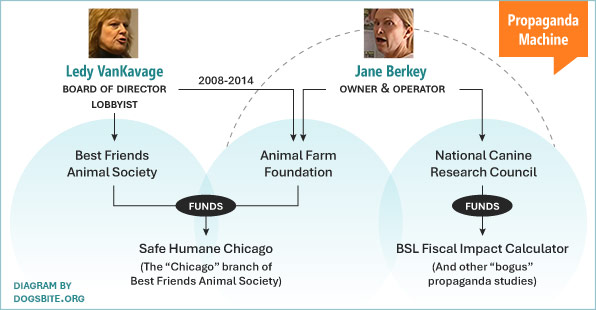
Maul Talk Manual
DogsBite.org - In September 2010, Maul Talk Manual Version 1.0, A Guide to Understanding the Language of Pit Bull Owners and Advocates, was launched. The manual is now in Version 2.0 and holds nearly 200 terms about the U.S. pit bull mauling epidemic. City officials considering breed-specific legislation should browse the manual, as you will interface with these terms and distortion tactics employed by pit bull owners, advocates and animal groups also tracked by the website.
Version 2.0 brings the frontrunners of the pit bull disinformation campaign into sharper focus, which continues to be Ledy Vankavage -- a lobbyist for Best Friends Animal Society and board member of Animal Farm Foundation -- and the National Canine Research Council. The latter two companies are owned and operated by Jane Rotrosen Berkey.1 These two middle-aged women are the primary forces that "seed" and steer the weighty U.S. pit bull propaganda machine.
Along with Vankavage and Berkey et al., pumping out volumes of dangerous disinformation for their followers to disseminate across the Internet, they also target and exploit "real" animal lovers who readily believe the myth, "It's all how you raise them." They leverage this naïve advocacy base (often young adult females) to help spread their agenda. Unwittingly, these same activists escalate the number of pets and livestock slaughtered annually by pit bull animal aggression.
The Pit Bull Propaganda Machine

Some terms have taken new form or have been made obsolete in Version 2.0, including Pit Nutter, which has been shorten to "Nutter," and now specifically designates "purveyors" of false pit bull myths. "Nanny Dog" was made obsolete due to factual historical research and Bad Rap finally admitting the myth to be false, though for a fictitious reason, during Dog Bite Prevention Week 2013. The ASPCA and Best Friends, however, still endorse the myth on their corporate websites.
Another obsolete term is "bait dogs." Last year, blogger Snack Sized Dog, caught Animal Farm Foundation dictating to their minions that, "bait dogs are mostly an urban legend." For a long time, pit bull advocates used this deceptive term to describe any scarred, worn toothed, cowering or stolen pit bull. The term was used to amplify pit bull victimization, as well as to obscure fighting dogs seized from busts, allegedly, "They're only bait dogs, and can be rehabilitated in a snap!"
Berkey's group begged their followers to discard the term because it "perpetuates the stereotypes and discrimination against 'pit bull' dogs."
As Snack Size Dog predicted in the 2012 post, the discarding of "bait dogs" was a strategic step toward declaring dogfighting an urban myth for the same reasons. In July, Megan Stearns of the Humane Society of Chittenden County upped the ante claiming, "there is no shared genetic lineage among dogs commonly assumed to be pit bulls" -- aka thousands of years of selective breeding for bull baiting2 and a few hundred more for dogfighting is simply a "social construct."
On a related note, Stearns' letter to the editor was in response to a pit bull article published by Seven Days in late June, "Local Ad Campaign Seeks to Soften Pit Bulls' Dangerous Image," that featured Miss Vermont kissing a pit bull. In fanatical, fringe rhetoric -- growing more common in humane groups -- Stearns complained that the article was "unbalanced" and no better than a "racial slur afflicting people," causing the "mass destruction of thousands" of family pit bulls.3
In a 2013 report, Animal People estimates that two-thirds of the pit bulls entering U.S. shelters annually are surrendered by their "keeper."4
Zealous, misguided activists like Stearns have few reasoning capabilities and always choose to ignore documented facts. When breed-specific pit bull laws are enacted two things happen: 1.) Attacks by pit bulls decrease5 and 2.) Shelter population and euthanasia rates of pit bulls decrease.6 What happens after a city repeals a pit bull law? Cincinnati repealed their longstanding pit bull ban nearly 1.5 years ago. Here are the results from August (Caution: pit bull puff piece):
It has been nearly 15 months since Cincinnati repealed its ban on pit bulls, deciding no longer to label the dogs as vicious by definition. So people can own pits – and they can also get rid of them ... At the end of July, at the Sharonville facility, SPCA President and CEO Harold Dates identified 62 of the 90 available animals as appearing to be possibly pit bulls or pit bull mix. The results were similar in the SPCA facility in Northside on a recent visit, when 41 of the 48 dogs up for adoption appeared to be pit bull breeds, which have a fairly distinct look. (John Faherty, Cincinnati.com, Aug 5, 2013)
The "ridders" are likely people who bought into deceptive propaganda -- brewed and circulated by Vankavage and Berkey -- then realized the truth. Note the time frame in Cincinnati, 15 months. Pit bulls begin to show destructive behavior traits, such as the "hold and shake" bite style and animal aggression, when sexual maturity is reached at about 1.5 years old. Puppies are not sold at birth, but rather at 2 to 3 months of age, thus the Cincinnati shelter numbers are hardly a revelation.
As the language of pit bull owners, "breed enthusiasts" and extreme pit bull advocacy groups shifts and grows, the Maul Talk Manual will continue to track these terms and trends. The Maul Talk Manual is also a free Android app. Submissions can be sent to maultalker --at-- gmail.com
Recent Maul Talk Manual 2.0 Terms
- “I heard it on NPR” - This term stems from an underhanded attack on Jeff Borchardt, the father of a boy killed by his babysitter’s two pit bulls in Wisconsin. After his death, a pit bull defender alleged in a Letter to the Editor that Borchardt was negligent and that she "heard a story on NPR" about a Wisconsin toddler that was killed by a Jack Russell -- as a comparison -- but NPR never ran such a story.
- “So sorry for your loss … BUT” - Refers to a branch of zealous pit bull advocates who comment on mauling threads or write directly to the parents of children killed by a pit bull. They care “nothing for social norms and will break them with impunity if it serves their purpose.” which in this case involves defending the pit bull breed. The “BUT” follows the superficial expression of trying to appear socially normal.
- “Just like any other dog” - Pit bulls are “just like any other dog” is a phrase mainly trumpeted by animal groups connected to Ledy Vankavage, such as Best Friends Animal Society (lobbyist) and Animal Farm Foundation (board member). Unlike a similar phrase used by the same groups, “all dogs are individuals,” the slogan, pit bulls are “just like any other dog,” is a total denial of the existence of breed traits.
- “OPIG” - A recent gathering in Riverside, California shows another Organized Pit Bull Idiocy Group (OPIG) marching to ensure that the colossal animal control resources already consumed by pit bulls continues unchecked and that maulings by pit bulls continue ad nauseum. OPIGs offer no solutions to shelters filled with unwanted pit bulls from coast to coast. Nor do they offer solutions to reduce mauling injuries.
- “Stockholm Nutter” - Stockholm Nutter is derived from the base term “Nutter” and is part of several combined terms, such as pre- and post-Nutter. A Stockholm Nutter is exactly what it suggests: A pit bull owner who has been at the receiving end of the destruction these dogs inflict, but still has empathy, sympathy and positive feelings for the breed. Stockholm syndrome is described as a form of “traumatic bonding."
- “I don't understand it" - After the catastrophic pit bull mauling of Linda Henry, her boyfriend said, “I don’t know why they did it … I don’t understand it.” Three of the couple’s pit bulls ambushed Henry after she walked into her home. The woman lost an eye, ear and both arms in the horrific assault. “I don’t understand it” is the denial of well documented attack traits repeatedly seen in damaging pit bull maulings.
- “Could not stop it” - After a pet pit bull attacked Ryan Maxwell killing him, the dog's owner, Ashiya Ferguson, emphatically declared: “Oh God, it was so horrible. I couldn’t stop it. I couldn’t stop it. I couldn’t stop it.” Ferguson is hardly alone in the inability to stop a tenacious pit bull attack, which is part one of why some cities regulate this dog breed. Part two is the damage this breed inflicts during its assault.
2While bull baiting was popular in the Middle Ages, many pit bull websites trace the blood sport back to the Romans and Greeks. The "holding and pinning" of the bull (or bear) is what developed the breed's damaging bite style.
3Note to Stearns: As revealed in the 2013 U.S. shelter report published in Animal People, as well as the data about Cincinnati shelters, pit bull "keepers" are largely to blame for the so-called "mass destruction" of these dogs.
4U.S. progress toward becoming a no-kill nation stalled in 2012-2013, by Merritt Clifton, Animal People, July/August 2013, Pg 12-13.
5Cities with Successful Pit Bull Laws; Data Shows Breed-Specific Laws Work, by DogsBite.org, Updated July 16, 2013.
62011 U.S. shelter killing data update, by Merritt Clifton, Animal People, July/August 2011.
Related articles:
08/31/15: Who Can Identify a Pit Bull? A Dog Owner of 'Ordinary Intelligence'...
07/26/13: Beyond the Interview: Essay of a Fatal Pit Bull Mauling
07/16/13: Cities with Successful Pit Bull Laws; Data Shows Breed-Specific Laws Work
05/31/13: Westwego Woman Loses Eye, Ear and Both Arms After Pet Pit Bulls Attack
03/10/13: 2013 Dog Bite Fatality: 7-Year Old 'Visiting' Galesburg Boy Killed by Pit Bull
09/24/10: Maul Talk Manual 1.0: A Guide to Understanding the Language of Pit Bull Owners...

It's the same everywhere. Where a pit bull ban is repealed, this is disastrous not only for the community but also for the pit bulls. Where bans are in place, there are only a few pit bulls in shelters awaiting euthanasia. As soon as any ban is repealed, shelters begin again to be flooded by pit bull types, all of them dumped by their 'loving' owners.
These people claim during a ban that they can't live without possessing a pit bull, are greatly suffering due to their choice being so limited (to only about 400 other types of dog), and are crying themselves to sleep at night thinking about all the poor pit bulls euthanised because of the ban.
The instant a ban is lifted, they run out and get one or more pit bulls. Within a very short time, this 'beloved' animal they couldn't live without ends up at a shelter. Suddenly the pit bull 'lovers' don't mind at all that a hundredfold of pit bulls are being born only to be put down compared to during any ban. That's apparently okay as long as they are the ones choosing to do this to these animals.
These facts indicate that the entire pit bull lobby is not at all concerned about animal welfare or well-being at all. It's not only the fate of the normal animals slaughtered en masse by pit bulls that leaves them indifferent, but in fact also the fate of the thousands of pit bulls they themselves breed then dump.
It's the same story all over the world, again and again:
http://17barks.blogspot.nl/2012/06/pit-bulls-and-shelter-bankruptcy.html